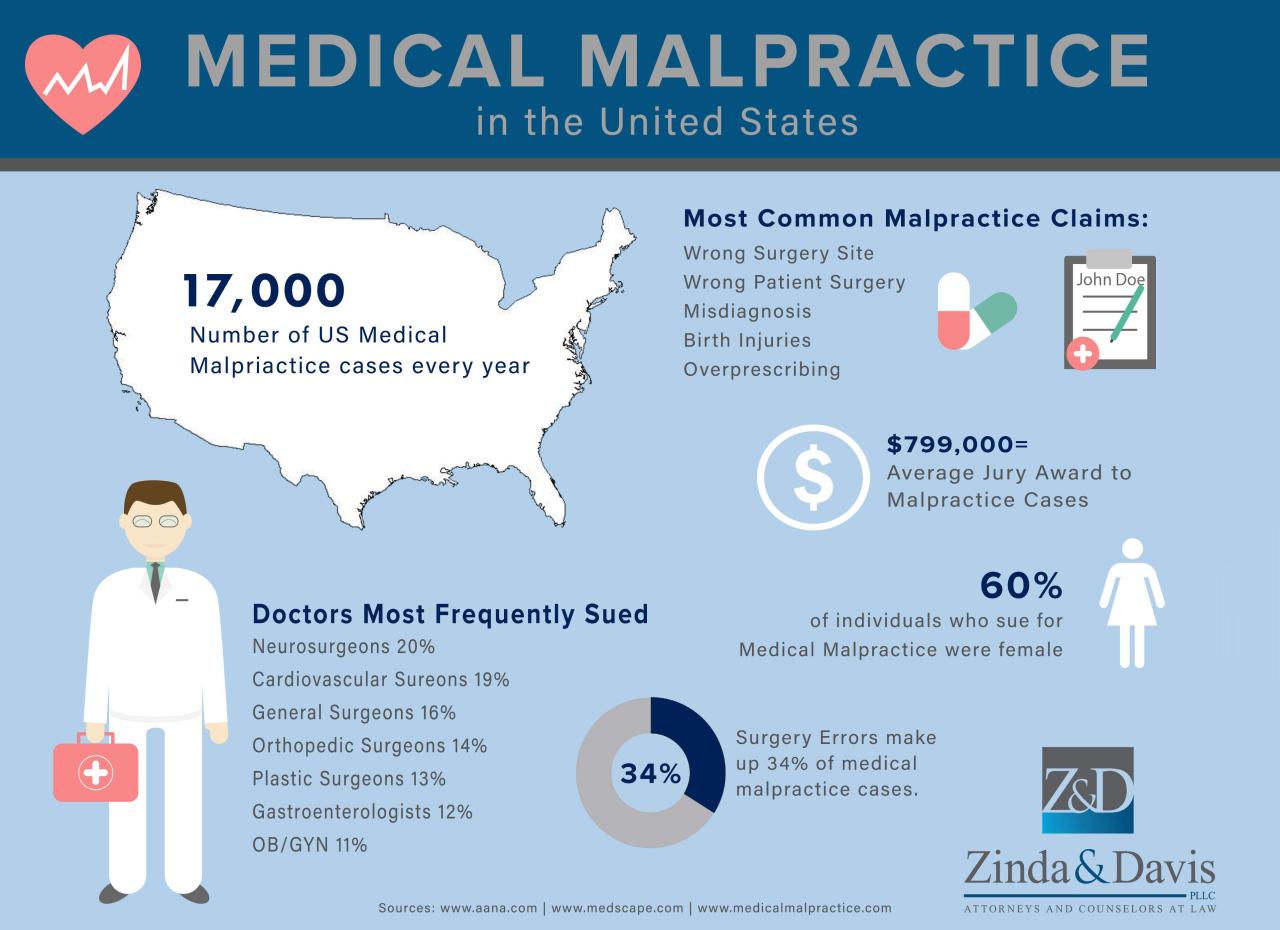
Understanding Medical Malpractice

Medical malpractice is a legal term used to describe situations where a healthcare professional’s negligence or wrongdoing results in harm to a patient. It is a serious matter that can have significant consequences for both the victim and the healthcare provider.
There are many different types of medical malpractice cases, including:
- Misdiagnosis or failure to diagnose
- Surgical errors
- Medication errors
- Birth injuries
- Anesthesia errors
In order to prove a medical malpractice claim, the plaintiff must show that:
- The healthcare provider owed the patient a duty of care.
- The healthcare provider breached that duty of care.
- The breach of duty caused the patient’s injuries.
- The patient suffered damages as a result of their injuries.
Choosing a Lawyer for Medical Malpractice
Selecting the right lawyer for your medical malpractice case is crucial. A skilled attorney can guide you through the complexities of the legal system, protect your rights, and maximize your compensation.
Qualities of a Medical Malpractice Lawyer
- Experience and Specialization: Look for a lawyer who has extensive experience handling medical malpractice cases and has a deep understanding of medical law.
- Reputation: Research the lawyer’s reputation among peers and clients. Positive reviews and referrals indicate a track record of success.
- Communication Skills: Effective communication is vital. Choose a lawyer who can clearly explain complex legal concepts and keep you informed throughout the process.
- Empathy and Compassion: Medical malpractice cases can be emotionally taxing. Find a lawyer who understands your pain and treats you with empathy.
- Contingency Fee Structure: Many medical malpractice lawyers work on a contingency fee basis, meaning you only pay if you win your case.
Finding a Qualified Lawyer
- Referrals: Ask friends, family, or other healthcare professionals for recommendations.
- Online Directories: Search online directories such as the American Bar Association’s website for lawyers specializing in medical malpractice.
- Legal Aid Organizations: Contact legal aid organizations for assistance in finding a qualified lawyer.
- Interview Potential Lawyers: Schedule consultations with several lawyers to discuss your case and assess their experience, qualifications, and personality.
The Legal Process for Medical Malpractice
The legal process for medical malpractice involves a series of stages, each with its own distinct purpose and procedures. Understanding these stages is crucial for both plaintiffs and defendants in pursuing or defending a medical malpractice lawsuit.
The Stages of a Medical Malpractice Lawsuit
- Pre-Filing Investigation: Before filing a lawsuit, potential plaintiffs typically conduct a thorough investigation to gather evidence and determine if they have a valid claim.
- Filing the Complaint: Once an investigation has established a reasonable basis for a claim, the plaintiff files a formal complaint with the court, outlining the allegations of medical negligence.
- Service of Process: The defendant is officially notified of the lawsuit by being served with the complaint and summons.
- Discovery: Both parties engage in a process of discovery, where they exchange information, documents, and evidence relevant to the case.
- Mediation: In some cases, the parties may participate in mediation, a form of alternative dispute resolution where a neutral third party facilitates negotiations.
- Trial: If mediation is unsuccessful, the case proceeds to trial, where a jury or judge hears evidence and determines liability and damages.
- Appeal: Either party may appeal the verdict of the trial court to a higher court if they believe there were errors in the proceedings.
The Role of the Plaintiff and Defendant
The plaintiff in a medical malpractice lawsuit is the individual or entity who has suffered harm as a result of alleged medical negligence. The defendant is the healthcare professional or institution being sued.
The plaintiff’s primary responsibility is to prove that the defendant breached their duty of care, causing the plaintiff’s injuries. The defendant, on the other hand, aims to demonstrate that they did not breach their duty of care or that the plaintiff’s injuries were not caused by their actions.
The Evidence and Discovery Process
Evidence plays a crucial role in medical malpractice lawsuits. Plaintiffs typically rely on medical records, expert testimony, and other documents to support their claims. Defendants may present evidence to refute the plaintiff’s allegations or to establish mitigating circumstances.
Discovery is a vital stage in the legal process, as it allows both parties to gather information and prepare for trial. During discovery, parties can request documents, interrogate witnesses, and take depositions. This process helps to ensure that both sides have a fair opportunity to present their case and that all relevant evidence is considered.
Damages in Medical Malpractice Cases

Damages in medical malpractice cases compensate victims for the harm they have suffered due to the negligence of a medical professional. These damages can include both economic and non-economic losses.
Economic Damages
* Medical expenses: Past and future medical expenses related to the malpractice, including hospital stays, surgeries, medications, and rehabilitation.
* Lost income: Wages lost due to the injury or disability caused by the malpractice.
* Loss of earning capacity: Future income that the victim is unable to earn due to permanent disability or impairment.
Non-Economic Damages
* Pain and suffering: Physical and emotional pain and suffering experienced as a result of the malpractice.
* Emotional distress: Anxiety, depression, or other emotional distress caused by the malpractice.
* Loss of enjoyment of life: Inability to engage in activities or experiences that the victim previously enjoyed due to the malpractice.
Calculating Damages
Damages in medical malpractice cases are typically calculated based on the following factors:
* Severity of the injury
* Extent of the medical expenses
* Loss of income and earning capacity
* Pain and suffering
* Emotional distress
* Loss of enjoyment of life
Factors Affecting Damages
The amount of damages awarded in a medical malpractice case can be affected by several factors, including:
* State laws: Damages caps or limits vary by state.
* Contributory negligence: If the victim contributed to their own injuries, their damages may be reduced.
* Insurance coverage: The amount of insurance coverage available to the defendant may limit the damages awarded.
* Jury discretion: Juries have some discretion in determining the amount of damages to award.
Alternative Dispute Resolution in Medical Malpractice

Alternative dispute resolution (ADR) methods provide an alternative to traditional litigation for resolving medical malpractice claims. These methods can be less adversarial, more efficient, and less expensive than going to court.
There are several different types of ADR methods available in medical malpractice cases, including:
- Mediation is a process in which a neutral third party (the mediator) helps the parties to reach a settlement. The mediator does not make any decisions for the parties, but instead facilitates the negotiation process.
- Arbitration is a process in which a neutral third party (the arbitrator) makes a binding decision on the case. The arbitrator’s decision is typically final and binding on both parties.
- Neutral evaluation is a process in which a neutral third party (the evaluator) provides the parties with an evaluation of the case. The evaluator’s opinion is not binding on the parties, but it can help them to reach a settlement.
Each of these ADR methods has its own advantages and disadvantages.
Mediation
Mediation is often a less adversarial and more efficient way to resolve medical malpractice claims than litigation. Mediation can also be less expensive than litigation.
However, mediation is not always successful. If the parties are unable to reach a settlement, they may still need to go to court.
Arbitration
Arbitration is a more binding form of ADR than mediation. The arbitrator’s decision is typically final and binding on both parties.
However, arbitration can also be more expensive than mediation. Additionally, the parties may have less control over the process and the outcome of the case.
Neutral Evaluation
Neutral evaluation is a less binding form of ADR than arbitration. The evaluator’s opinion is not binding on the parties, but it can help them to reach a settlement.
Neutral evaluation can be a helpful way to get an outside perspective on the case. However, it can also be expensive, and it may not always be successful in resolving the case.





